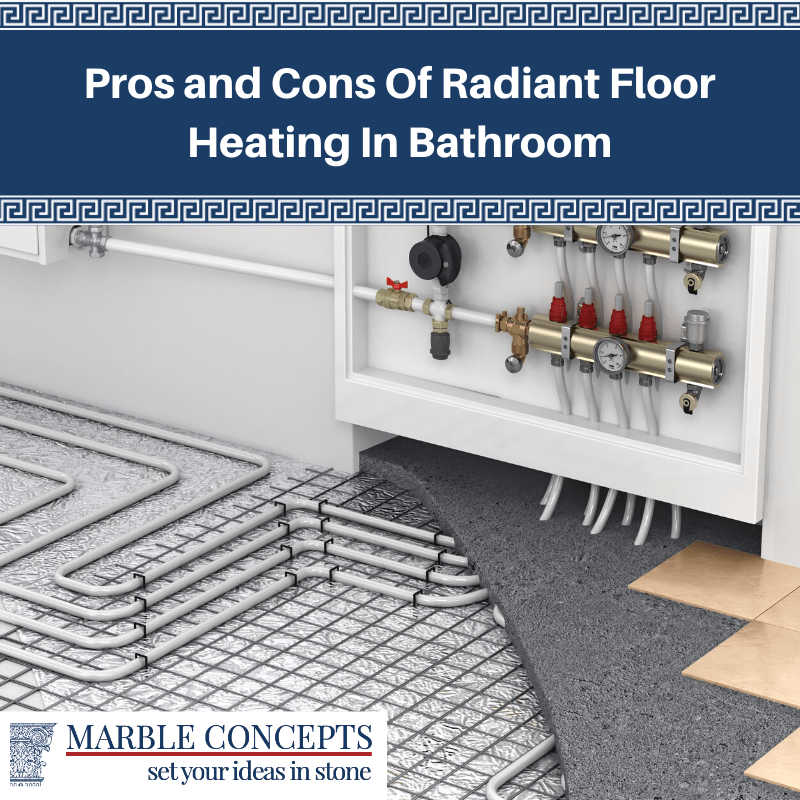Heated bathroom floors can create an opulent atmosphere that exudes spa-like luxury and fine beauty. Many homeowners wonder if the cost and effort of installing radiant floor heating in their bathrooms is worth it when it’s all said and done. Read on for some relevant pros and cons of radiant floor heating in bathrooms before making a final decision.
Heating with a Traditional Forced Air System Overview
Most homes today have a heating and/or cooling system that includes a furnace or HVAC unit that forces warmer air through ventilation ductwork that is installed throughout the house. A drawback of this type of heating is that warmer air rises.
As the furnace kicks on when the thermostat sensors indicate the room is cooling down, that heated air immediately starts to rise towards the ceiling where it is really not needed. Another issue is that the temperature of the room is dependent on whether the air vents are positioned so that the entire room is heated rather than just near the air vent.
Forced air heating can leave cold spots in a room due to uneven heating and loss of heat through duct leaks along with the rising nature of warmed air. As heat rises, the floor becomes chilly especially if they are made of tile, laminate or wood.
In addition, a forced-air furnace only turns on when the thermostat senses a drop in temperature. Since the heated air escapes upward quickly, the furnace must work harder to reheat the entire room space all over again making this heating option less cost-effective when compared to radiant floor heating.
What Is Radiant Heat Exactly?
Unlike forced-air heating, radiant heat works by heating the bathroom floor in a consistent and more encompassing manner. There are two types of radiant heat options. These are:
- Electric radiant heating systems
- Hydronic floor heating system
Electric radiant heating:
This type of floor heating uses electrical currents that work with a heating element that is in the form of electrical coils installed directly beneath the flooring. The coils are typically laid out in an even serpentine pattern like the letter S or a snake shape.
Radiant heating is released slower and is consistent over the entire bathroom floor. These coils take less time to heat averaging about 30-60 minutes. This is a more cost-effective heating when compared to forced air heat that must constantly turn on and off.
Since the whole floor is heated, there are less chilly drafts. A person feels warmer because the heated air stays lower longer and the flooring isn’t freezing making it more comfortable to walk on.
Overall, radiant heating installed in a bathroom, or other smaller space, is usually relatively reasonable in price. Someone handy with home improvement projects can often perform this work themselves.
Hydronic floor heating
Hydronic floor heating systems work by using convection, conduction, and radiation. Instead of electrical coils, this type of system uses tubes containing a liquid that is placed underneath the flooring. This heating option requires a boiler system to produce conduction needed to heat up the water inside of the tubes.
Radiant heat generated by hydronic floor heating systems tend to be less costly with regards to energy bills. However, if a home does not have a boiler system already, the steep purchase and installation costs can be expensive.
Is Radiant Floor Heating Always More Energy Efficient?
In general, radiant floor heating in a smaller area, like a bathroom or small bedroom, is usually more energy-efficient than the standard forced heat systems. However, larger spaces being heated solely with radiant floor heating seem to lose their energy efficiency level.
Many homeowners use radiant floor heating in addition to another heating source to make those cold spots inside a home feel more comfortable.
Pros & Cons of Radiant Floor Heating
Pros:
- Even & consistent heating
- Keeps heated air lower for greater comfort
- Runs quieter than forced air systems
- Less or zero maintenance requirements
- Usually more cost-effective
- Can be more energy-efficient
- Better air quality
- Relatively easy installation
Cons:
- Raises floor level slightly
- Must replace flooring
- Cost factors
The best way to determine which heating option is right for your home heating needs is to speak with a reliable heating and flooring specialist.






